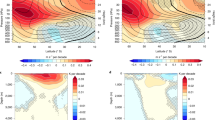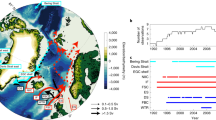Abstract
The large-scale moistening of the atmosphere in response to increasing greenhouse gases amplifies the existing patterns of precipitation minus evaporation (P − E), which, in turn, amplifies the spatial contrast in sea surface salinity. Here, by performing a series of transient CO2 doubling experiments, we demonstrate that surface salinification driven by the amplified dry conditions (P − E < 0), primarily in the subtropical ocean, accelerates ocean heat uptake. The salinification also drives the sequestration of upper-level heat into the deeper ocean, reducing the thermal stratification and increasing the heat uptake through positive feedback. The change in Atlantic Meridional Overturning Circulation due to salinification has a secondary role in heat uptake. Consistent with the heat uptake changes, the transient climate response would increase by approximately 0.4 K without this process. Observed multidecadal changes in subsurface temperature and salinity resemble those simulated, indicating that anthropogenically forced changes in salinity are probably enhancing ocean heat uptake.
This is a preview of subscription content, access via your institution
Access options
Access Nature and 54 other Nature Portfolio journals
Get Nature+, our best-value online-access subscription
$29.99 / 30 days
cancel any time
Subscribe to this journal
Receive 12 print issues and online access
$209.00 per year
only $17.42 per issue
Buy this article
- Purchase on Springer Link
- Instant access to full article PDF
Prices may be subject to local taxes which are calculated during checkout





Similar content being viewed by others
Data availability
The NCEI ocean salinity and temperature data are available online (https://www.nodc.noaa.gov/OC5/3M_HEAT_CONTENT/). The JMA data are available online (https://climate.mri-jma.go.jp/pub/ocean/ts/v7.3/). The IAP data are available at http://159.226.119.60/cheng/. The ORAS4 data are available at ftp://ftp-icdc.cen.uni-hamburg.de/EASYInit/ORA-S4/. The input data for running the FLOR experiments presented in this work and processed data for graphics from the four datasets and FLOR model outputs are available at tigress-web at Princeton University (http://tigress-web.princeton.edu/~maofeng/SSS_OHU_TCR/data/).
Code availability
The climate model used in this study is GFDL FLOR with code available at the NOAA/GFDL website (https://www.gfdl.noaa.gov/cm2-5-and-flor/). All graphics were produced using Python v.3.6 (https://www.python.org/downloads/release/python-360/). The codes needed to set up the FLOR experiment and Python scripts used for analyses and producing main figures are available at GitHub (https://github.com/maofeng2012/SSS_OHC_TCR; https://doi.org/10.5281/zenodo.5149277).
References
Mitchell, J. F. B., Manabe, S., Meleshko, V. & Tokioka, T. in IPCC Climate Change: The IPCC Scientific Assessment (eds Houghton, J. T., Jenkins, G. J. & Ephraums, J. J.) (Cambridge Univ. Press, 1990).
Cheng, L., Abraham, J., Hausfather, Z. & Trenberth, K. E. How fast are the oceans warming? Science 363, 128–129 (2019).
Trenberth, K. E., Fasullo, J. T. & Balmaseda, M. A. Earth’s energy imbalance. J. Clim. 27, 3129–3144 (2014).
Li, G. et al. Increasing ocean stratification over the past half-century. Nat. Clim. Chang. 10, 1116–1123 (2020).
Stevens, S. W., Johnson, R. J., Maze, G. & Bates, N. R. A recent decline in North Atlantic subtropical mode water formation. Nat. Clim. Chang. 10, 335–341 (2020).
Ishii, M. et al. Accuracy of global upper ocean heat content estimation expected from present observational data sets. Sola 13, 163–167 (2017).
Cheng, L. et al. Improved estimates of ocean heat content from 1960 to 2015. Sci. Adv. 3, e1601545 (2017).
Domingues, C. M. et al. Improved estimates of upper-ocean warming and multi-decadal sea-level rise. Nature 453, 1090–1093 (2008).
Abraham, J. P. et al. A review of global ocean temperature observations: implications for ocean heat content estimates and climate change. Rev. Geophys. 51, 450–483 (2013).
von Schuckmann, K. et al. Heat stored in the Earth system: where does the energy go? Earth Syst. Sci. Data 12, 2013–2041 (2020).
Meyssignac, B. et al. Measuring global ocean heat content to estimate the earth energy imbalance. Front. Mar. Sci. 6, 432 (2019).
Taylor, K. E., Stouffer, R. J. & Meehl, G. A. An overview of CMIP5 and the experiment design. Bull. Am. Meteorol. Soc. 93, 485–498 (2012).
Larson, E. J. L., Portmann, R. W., Solomon, S. & Murphy, D. M. Decadal attribution of historic temperature and ocean heat content change to anthropogenic emissions. Geophys. Res. Lett. 47, e2019GL085905 (2020).
Bronselaer, B. & Zanna, L. Heat and carbon coupling reveals ocean warming due to circulation changes. Nature 584, 227–233 (2020).
Bilbao, R. A. F., Gregory, J. M., Bouttes, N., Palmer, M. D. & Stott, P. Attribution of ocean temperature change to anthropogenic and natural forcings using the temporal, vertical and geographical structure. Clim. Dyn. 53, 5389–5413 (2019).
Levitus, S. et al. World ocean heat content and thermosteric sea level change (0-2000 m), 1955-2010. Geophys. Res. Lett. 39, L10603 (2012).
Vecchi, G. A. et al. Tropical cyclone sensitivities to CO2 doubling: roles of atmospheric resolution, synoptic variability and background climate changes. Clim. Dyn. 53, 5999–6033 (2019).
Capotondi, A., Alexander, M. A., Bond, N. A., Curchitser, E. N. & Scott, J. D. Enhanced upper ocean stratification with climate change in the CMIP3 models. J. Geophys. Res. Oceans 117, C04031 (2012).
Durack, P. J. & Wijffels, S. E. Fifty-year trends in global ocean salinities and their relationship to broad-scale warming. J. Clim. 23, 4342–4362 (2010).
Durack, P. J., Wijffels, S. E. & Matear, R. J. Ocean salinities reveal strong global water cycle intensification during 1950 to 2000. Science 336, 455–458 (2012).
Skliris, N. et al. Salinity changes in the World Ocean since 1950 in relation to changing surface freshwater fluxes. Clim. Dyn. 43, 709–736 (2014).
Terray, L. et al. Near-surface salinity as nature’s rain gauge to detect human influence on the tropical water cycle. J. Clim. 25, 958–977 (2012).
Lago, V. et al. Simulating the role of surface forcing on observed multidecadal upper-ocean salinity changes. J. Clim. 29, 5575–5588 (2016).
Held, I. M. & Soden, B. J. Robust responses of the hydrological cycle to global warming. J. Clim. 19, 5686–5699 (2006).
IPCC Climate Change 2013: The Physical Science Basis (eds Stocker, T. F. et al.) (Cambridge Univ. Press, 2013).
Bindoff, N. L. et al. IPCC Special Report on the Ocean and Cryosphere in a Changing Climate 477–587 (IPCC, 2019).
Vecchi, G. A. et al. On the seasonal forecasting of regional tropical cyclone activity. J. Clim. 27, 7994–8016 (2014).
Gregory, J. M. & Mitchell, J. F. B. The climate response to CO2 of the Hadley Centre coupled AOGCM with and without flux adjustment. Geophys. Res. Lett. 24, 1943–1946 (1997).
Raper, S. C. B., Gregory, J. M. & Stouffer, R. J. The role of climate sensitivity and ocean heat uptake on AOGCM transient temperature response. J. Clim. 15, 124–130 (2002).
Stott, P. A., Sutton, R. T. & Smith, D. M. Detection and attribution of Atlantic salinity changes. Geophys. Res. Lett. 35, L21702 (2008).
Pierce, D. W., Gleckler, P. J., Barnett, T. P., Santer, B. D. & Durack, P. J. The fingerprint of human-induced changes in the ocean’s salinity and temperature fields. Geophys. Res. Lett. 39, 2–7 (2012).
Stouffer, R. J. et al. Investigating the cause of the response of the thermohaline circulation to past and future climage changes. J. Clim. 19, 1365–1387 (2006).
Liu, W., Fedorov, A. V., Xie, S.-P. & Hu, S. Climate impacts of a weakened Atlantic Meridional Overturning Circulation in a warming climate. Sci. Adv. 6, eaaz4876 (2020).
Levang, S. J. & Schmitt, R. W. What causes the AMOC to weaken in CMIP5? J. Clim. 33, 1535–1545 (2019).
Silvy, Y., Guilyardi, E., Sallée, J.-B. & Durack, P. J. Human-induced changes to the global ocean water masses and their time of emergence. Nat. Clim. Chang. 10, 1030–1036 (2020).
Robson, J., Ortega, P. & Sutton, R. A reversal of climatic trends in the North Atlantic since 2005. Nat. Geosci. 9, 513–517 (2016).
Jackson, L. C., Peterson, K. A., Roberts, C. D. & Wood, R. A. Recent slowing of Atlantic overturning circulation as a recovery from earlier strengthening. Nat. Geosci. 9, 518–522 (2016).
Thornalley, D. J. R. et al. Anomalously weak Labrador Sea convection and Atlantic overturning during the past 150 years. Nature 556, 227–230 (2018).
Caesar, L., Rahmstorf, S. & Feulner, G. On the relationship between Atlantic meridional overturning circulation slowdown and global surface warming. Environ. Res. Lett. 15, 24003 (2020).
Armour, K. C., Marshall, J., Scott, J. R., Donohoe, A. & Newsom, E. R. Southern Ocean warming delayed by circumpolar upwelling and equatorward transport. Nat. Geosci. 9, 549–554 (2016).
Meehl, G. A. et al. Context for interpreting equilibrium climate sensitivity and transient climate response from the CMIP6 Earth system models. Sci. Adv. 6, eaba1981 (2020).
Jia, L. et al. Improved seasonal prediction of temperature and precipitation over land in a high-resolution GFDL climate model. J. Clim. 28, 2044–2062 (2015).
Soden, B. J. et al. Quantifying climate feedbacks using radiative kernels. J. Clim. 21, 3504–3520 (2008).
Zhang, B., Kramer, R. J. & Soden, B. J. Radiative feedbacks associated with the Madden–Julian oscillation. J. Clim. 32, 7055–7065 (2019).
Kramer, R. J., Matus, A. V., Soden, B. J. & L’Ecuyer, T. S. Observation-based radiative kernels from CloudSat/CALIPSO. J. Geophys. Res. Atmos. 124, 5431–5444 (2019).
Cerovecki, I., Talley, L. D. & Mazloff, M. R. A Comparison of Southern Ocean air-sea buoyancy flux from an ocean state estimate with five other products. J. Clim. 24, 6283–6306 (2011).
Cheng, L. et al. Improved estimates of changes in upper ocean salinity and the hydrological cycle. J. Clim. 33, 10357–10381 (2020).
Balmaseda, M. A., Mogensen, K. & Weaver, A. T. Evaluation of the ECMWF ocean reanalysis system ORAS4. Q. J. R. Meteorol. Soc. 139, 1132–1161 (2013).
Acknowledgements
This work was supported by award 80NSSC20K0879 from the National Aeronautics and Space Administration and award DE-SC0021333 from the US Department of Energy. The simulations presented in this paper were performed on computational resources managed and supported by Princeton Research Computing at Princeton University.
Author information
Authors and Affiliations
Contributions
B.S., G.V. and M.L. designed the research. G.V., M.L. and W.Y. performed the simulations. M.L. and B.Z. performed the analysis. M.L. wrote the draft. All of the authors contributed to interpreting the results and writing the paper.
Corresponding author
Ethics declarations
Competing interests
The authors declare no competing interests.
Additional information
Peer review information Nature Climate Change thanks Veronique Lago, M. Cameron Rencurrel and the other, anonymous, reviewer(s) for their contribution to the peer review of this work.
Publisher’s note Springer Nature remains neutral with regard to jurisdictional claims in published maps and institutional affiliations.
Supplementary information
Supplementary Information
Supplementary Text 1 and 2, Figs. 1–20 and Table 1.
Rights and permissions
About this article
Cite this article
Liu, M., Vecchi, G., Soden, B. et al. Enhanced hydrological cycle increases ocean heat uptake and moderates transient climate change. Nat. Clim. Chang. 11, 848–853 (2021). https://doi.org/10.1038/s41558-021-01152-0
Received:
Accepted:
Published:
Issue Date:
DOI: https://doi.org/10.1038/s41558-021-01152-0
This article is cited by
-
Hydrological cycle amplification reshapes warming-driven oxygen loss in the Atlantic Ocean
Nature Climate Change (2024)
-
AMO modulation of interdecadal background of persistent heavy rainfall in summer over the Huaihe River Basin
Climate Dynamics (2024)
-
Past and future ocean warming
Nature Reviews Earth & Environment (2022)



